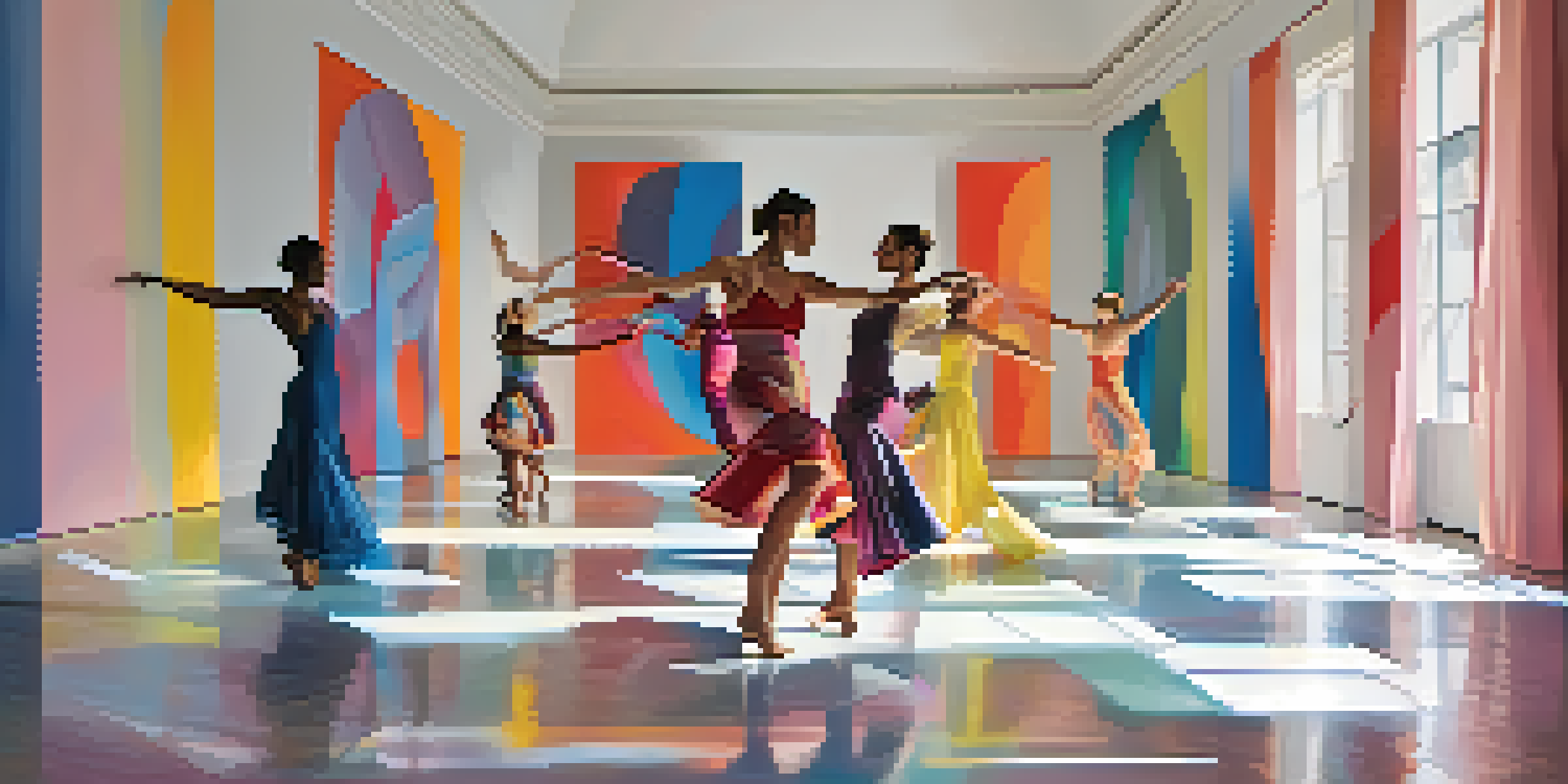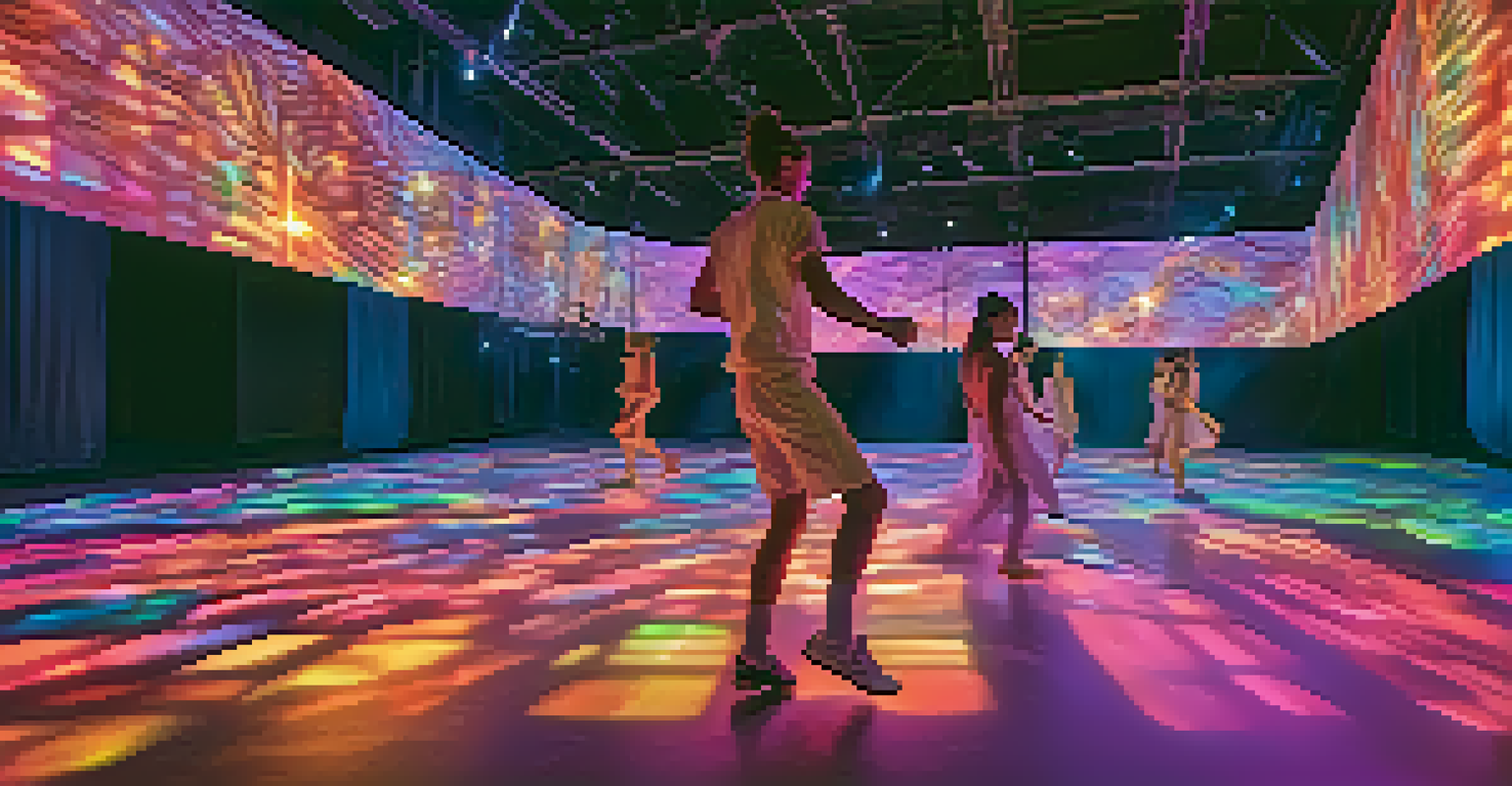The Intersection of Dance and Visual Art in Performance

Understanding the Fusion of Dance and Visual Art
Dance and visual art share a unique relationship that enhances performance. At their core, both art forms express emotion and tell stories, often intertwining to create a richer experience. When dancers move, their bodies can become part of a larger visual canvas, making the performance more immersive for the audience.
Dance is the hidden language of the soul.
This fusion is not just about aesthetics; it’s about communication. Visual elements can amplify the emotional impact of dance, while movement can bring life to static art. By working together, these art forms invite viewers to engage with the performance on multiple levels, sparking a deeper connection.
Consider a performance where dancers interact with projected images or sculptures. The visual art can transform the stage into a dynamic environment, giving context to the movements. This synergy allows artists to push boundaries and explore new narratives, making each performance a unique experience.
Historical Perspectives on Dance and Visual Art Collaboration
Historically, the collaboration between dance and visual art can be traced back to various cultural movements. From the Ballets Russes in the early 20th century, which incorporated innovative set designs and costumes, to contemporary performances that feature multimedia elements, this partnership has evolved significantly. Artists like Martha Graham and Alexander Calder exemplified this synergy, blending movement and visual aesthetics.

Throughout the years, artists have recognized the potential of combining these disciplines to create a multifaceted experience. The use of color, light, and form in visual art can amplify the themes and emotions in dance, making the performance more evocative. This historical interplay has paved the way for modern experimental works that challenge traditional boundaries.
Dance and Art: A Powerful Duo
The fusion of dance and visual art enhances emotional expression and creates immersive experiences for audiences.
As we look at the evolution of this collaboration, it’s clear that each era reflects its cultural and artistic values. The way dance and visual art intersect reveals insights into societal changes and artistic movements, enriching our understanding of both fields.
The Role of Technology in Dance and Visual Art
In today’s digital age, technology plays a pivotal role in the intersection of dance and visual art. Innovations such as projection mapping and interactive video installations have transformed how these art forms interact. Dancers can now manipulate visuals in real-time, creating a captivating dialogue between their movements and the surrounding imagery.
Art is not what you see, but what you make others see.
For instance, performances that utilize augmented reality allow audiences to experience dance in entirely new ways. The blending of physical movement with digital visuals can create environments that feel both real and surreal, inviting viewers to lose themselves in the moment. This technological integration has expanded the possibilities for storytelling and expression.
However, it’s essential to balance technology with the human element of performance. While tech can enhance a show, the raw emotion of dance should always remain at the forefront. By thoughtfully incorporating technology, artists can deepen the audience's connection to the performance without overshadowing its essence.
Choreography Inspired by Visual Art
Visual art often serves as a muse for choreographers, inspiring movement and expression. Dancers interpret paintings, sculptures, or installations, translating the visual into a physical language. This creative process allows choreographers to explore themes and emotions depicted in the artwork, creating a dialogue between the two forms.
For example, a choreographed piece based on a famous painting might mimic the colors and shapes found within the canvas. The movements can reflect the brushstrokes or the mood of the piece, inviting the audience to experience the artwork in a new light. This cross-pollination enriches both disciplines and results in performances that resonate deeply.
Technology Transforms Art Integration
Innovations like projection mapping and augmented reality are redefining how dance and visual art interact and engage viewers.
Through this artistic exploration, dancers and choreographers can challenge the viewer's perception of both dance and visual art. By creating a narrative that draws from visual inspiration, they encourage audiences to see familiar artworks from a fresh perspective, ultimately enhancing appreciation for both art forms.
The Emotional Impact of Combined Art Forms
The emotional impact of merging dance and visual art is profound. When these art forms collaborate, they can evoke powerful feelings that resonate with the audience. Dance can convey raw emotion, while visual elements can enhance that emotion through color, light, and symbolism, creating a layered experience that lingers long after the performance ends.
For instance, a dance piece set against a backdrop of abstract visuals can create a sense of chaos or harmony, depending on the movement and imagery used. This interplay can evoke memories, provoke thoughts, or even inspire action, making the performance a catalyst for emotional reflection. The combination allows for a nuanced exploration of the human experience.
Ultimately, the emotional synergy of dance and visual art opens up new avenues for expression. It invites audiences to engage not just as spectators but as participants in a shared emotional journey. This connection is what makes performances memorable and impactful.
Contemporary Trends in Dance and Visual Art Integration
Contemporary performances increasingly blur the lines between dance and visual art, embracing a range of styles and influences. Artists are experimenting with new formats, such as immersive installations that invite audience interaction. This trend fosters a more participatory experience, allowing viewers to engage with the performance physically and emotionally.
Choreographers are also collaborating with visual artists to create site-specific works that respond to their environment. These performances can transform everyday spaces into artful stages, encouraging audiences to see their surroundings in a different light. This approach not only enhances the performance but also creates a unique connection with the community.
Future Trends in Art Collaborations
The ongoing collaboration between dance and visual art is evolving, encouraging innovative storytelling and audience participation.
As these trends continue to evolve, they challenge traditional notions of both dance and visual art. The integration of various mediums encourages innovation and exploration, pushing artists to redefine their boundaries and create new narratives that resonate with today’s audiences.
The Future of Dance and Visual Art Collaborations
Looking ahead, the future of dance and visual art collaborations appears promising and exciting. As artists continue to explore new technologies and creative approaches, we can expect to see even more innovative performances that captivate and inspire. The ongoing dialogue between these two art forms will undoubtedly lead to fresh ideas and unique storytelling methods.
Moreover, the rise of social media and digital platforms has made it easier for artists to share their work with a global audience. This accessibility opens doors for diverse collaborations that may not have been possible in the past, enriching the artistic landscape. Emerging talents will have the opportunity to experiment and push the boundaries of what performance can entail.

Ultimately, the intersection of dance and visual art will continue to evolve, reflecting the changing times and cultural values. As these art forms grow together, they will undoubtedly create transformative experiences that resonate deeply with audiences around the world.